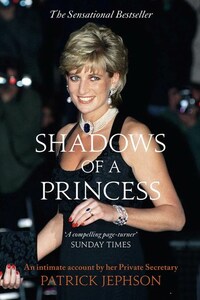COPYRIGHT
William Collins
An imprint of HarperCollinsPublishers
1 London Bridge Street
London SE1 9GF
www.WilliamCollinsBooks.com
This eBook first published in Great Britain by William Collins in 2017
Copyright © 2017 Prospect Media Ltd
Cover photograph © Tim Graham / Getty Images
Patrick Jephson asserts the moral right to be identified as the author of this work
A catalogue record for this book is available from the British Library
All rights reserved under International and Pan-American Copyright Conventions. By payment of the required fees, you have been granted the non-exclusive, non-transferable right to access and read the text of this e-book on-screen. No part of this text may be reproduced, transmitted, down-loaded, decompiled, reverse engineered, or stored in or introduced into any information storage and retrieval system, in any form or by any means, whether electronic or mechanical, now known or hereinafter invented, without the express written permission of HarperCollins
Source ISBN: 978-0-00-825929-7
Ebook Edition © July 2017 ISBN: 9780008260125
Version: 2017-07-17
PRAISE FOR SHADOWS OF A PRINCESS
‘The most indelible, authentic word-portrait ever painted of the People’s Princess’
Daily Mail
‘Jephson’s revelations are important. They are a stark corrective to the baroque fantasies constructed around the Princess immediately after her death’
Evening Standard
INTRODUCTION TO THE 2017 EDITION
You may sometimes wonder why Princess Diana still casts such a long shadow over Britain’s thousand-year-old ruling dynasty. Like me, you may welcome it as a gentle reminder that her story remains relevant, an enduring example of the good things royalty can achieve, as well as a warning of the price it can exact. Or, like some others, you may feel her shadow upon you as an irritation, since it points to the inconvenient reality of Diana’s popular and it seems permanent place among the most admired names of recent history. A few in this second group would have us believe that Diana and her admirers are classic examples of the modern fashion for emotional incontinence – a betrayal of the traditional British stiff upper lip: that in reality she was flawed and frail, a symbol of weakness not strength, and so whoever replaces her in the national shop window must now be more deserving of our interest and approval.
Yet twenty years after her death, the memory of Princess Diana is still obviously alive and well. The world’s media are once again graced by her image and by tributes to how much she achieved in her tragically short life. The causes she championed – from mental health, old age and homelessness to AIDS, addiction and leprosy – are living tributes to her effectiveness as a globally admired force for good; and her greatest living legacies, her sons, are inviting us to remember her with gratitude and affection. In their words: ‘The time is right to remember her positive impact’, and their tributes to her – symbolized by the commissioning of a statue at Kensington Palace – strike a chord with ordinary people of all ages all over the world.
Like many she felt ill-prepared and untrained for the role in which she found herself. Alone in a tradition-bound environment in which her successes seemed to count for little and her errors for a lot, she believed she had been left to sink or swim. And but for her sons, her private life offered no consolation, with a husband who, it appeared to many observers, saw her as a rival to be feared rather than a companion to be cherished. Instead his energy, time and attention were devoted to the older, more experienced wife of a former courtier who, like many of their secretive social circle, seemed impervious to the vulnerable princess’s anguish.
No wonder Diana suffered from chronic self-doubt, poor self-image and a persistent eating disorder. Through her eyes, there was no comfort in the trappings and privileges of palace life, let alone the adoration of a world that praised her for virtues she never truly felt she possessed. She looked to her in-laws and the palace hierarchy for advice and support and too often found that goodwill on both sides couldn’t stop relations descending from misunderstanding to mistrust, and worse.
Of course, Diana was not perfect, and never claimed to be. As I had good reason to know, she could be a capricious employer who rightly expected a royal standard of perfection from her small and at times beleaguered support staff – just as she demanded it from herself. But though there were days when I wished I could have had a more conventional boss, I never doubted that she was well worth the toil, sweat and occasional tears. Her gutsy response to such a daunting array of misfortunes had won my lasting admiration, just as it earned her a deserved place in the hearts of millions around the world.








